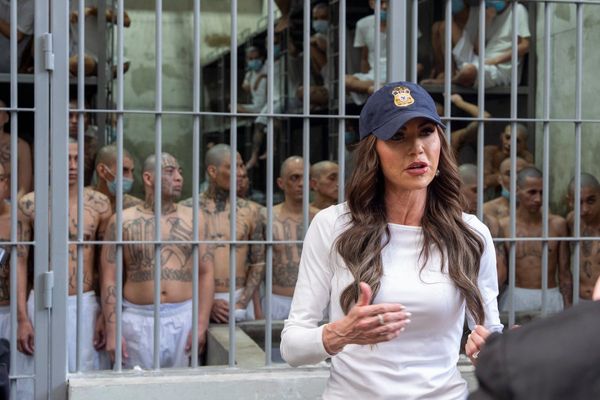
Given that we live in a time defined by the rise of far-right populism and a widespread indifference to traditional party politics, the idea of a unified “working class” seems almost romantic, a throwback to an age when Labour was synonymous with socialism rather than centrism. In this context, the Hayward Gallery’s touring exhibition After the End of History is a defiant statement, though it’s less a celebration of shared values and traditions than a series of revealing glimpses of what curator Johny Pitts describes as the “complex and counterintuitive expressions of working-class life”.
The show’s high-flown title refers to the political scientist Francis Fukuyama’s controversial assertion that history of a kind ended with the collapse of the Soviet Union and the triumph of liberal democracy. Much of the work on the walls is too personal and too local to be read in this context, but it does reflect Pitts’s stated aim to create an exhibition “full of contradictions, like working-class life is”.
In the long, narrow space that is Stills in Edinburgh, the resulting collision of styles and subject matter is initially overwhelming, with images that capture the kinetic energy of post-acid house club culture juxtaposed with formal portraiture, activist social documentary and conceptualism. What lends the show a much-needed narrative unity is Pitts’s insightful, often deeply personal commentary on the work. Responding to Richard Billingham’s rawly transgressive family pictures, for instance, he homes in on their “smell”; how they evoke the familiar “odours of home – fags, maybe alcohol, the grease from a frying pan”. It’s a far cry from the drily academic wall texts that usually attend such themed exhibitions, and in this instance works perfectly as an audacious subversion of the same: a kind of curatorial class war, if you like.
Throughout, the work of established artists such as Hannah Starkey, Elaine Constantine, Tom Wood and Chris Shaw hangs alongside less celebrated images by what might be called insider photographers working at ground level, whose style and subject matter reflect the life of people in their own communities. Often, the results tend towards the deftly observational, as with Kavi Pujara’s vibrant interiors and portraits of Leicester’s working-class Indian culture, or Rob Clayton’s keenly observed glimpses of the ordinariness of housing estate life in Oldbury in the West Midlands. There’s a quiet, cumulative power in both series that comes from their ability to evoke the atmosphere of the everyday.
I was taken too by JA Mortram’s series Small Town Inertia, an immersive documentary project that captures the sense of stasis suggested in its intriguing title. His subjects live in Dereham, a market town in Norfolk, where the sense of isolation and loneliness that pervades their lives is a symptom of deeper social issues exacerbated by what he describes as “physical and mental problems and a failing social security system”. Shot in stark monochrome, Mortram’s work is undoubtedly informed by his experience of being a full-time carer for his mother. Again, it is the establishment of a mood or atmosphere that intrigues.
In contrast, Sandra George’s almost diaristic social documentary series, made between the 1980s and 00s in working-class areas of Scotland, is a testament to the commitment of women like her, who raised families while engaging in community work and grassroots campaigning. In its entirety it comprises several thousand images, only a fraction of which are arranged, unframed, across a single wall. It captures the kind of dogged political engagement that once characterised a strain of leftwing, working-class experience, but now seems to have fractured alongside many of the communities it emerged from.
That sense of a not so recent past that suddenly seems irretrievably distant also resonates through the aptly named Nothing Lasts Forever, a retrospective of the work of a veteran of working-class photography Peter Mitchell, at the Photographers’ Gallery in London. Raised in south-east London, Mitchell studied at Hornsey College of Art during the tumult of protest and countercultural upheaval of the late 60s before relocating to Leeds in 1972.
His adopted city became his enduring subject, its rapidly changing nature recorded in a series of often mischievously titled exhibitions and books. They include A New Refutation of the Viking 4 Space Mission, in which blurry Nasa satellite images of the surface of Mars punctuate his stately photographs of Leeds’s streetscapes, shopfronts and Victorian buildings.
As this retrospective makes clear, Mitchell is something of an anomaly in British photography: a pioneer of colour whose documentary practice shades into a singular kind of eccentric conceptualism. A New Refutation of the Viking 4 Space Mission is still baffling curious visitors, his images of a British city in the throes of rapid redevelopment outlined by ruled measurements that lend a faux-scientific aspect to his Martian gaze.
Elsewhere, the brutal thrust of redevelopment is caught in his almost elegiac photographs of the demolition of the city’s Quarry Hill flats in the 1970s. It’s the interiors that haunt the soul: a pair of smart ladies’ shoes beneath an ornate wardrobe; a fitted wooden shelving unit, its drab brownness echoed in the bronze patina of the door, window frames and even the empty beer bottle that perches forlornly on an empty shelf. On one sunlit wall, the outline of a window frame bisects a framed picture of a too-cute fawn and falls just short of a publicity shot of the 60s and 70s Irish showband Big Tom and the Mainliners. This is the visual poetry of traces and remnants, the left-behind fragments of working-class lives, communities uprooted and scattered.
Mitchell, a poet of the disappearing city, also ventured into the country to photograph lone scarecrows, standing sentinel in unharvested cornfields like sinister tramps and teetering lopsidedly in the wintry wind and snow. They are the stuff of ancient legend and children’s nightmares, like stills from some obscure British B-movie or long-lost occult-themed TV series. “To me, they’re friends,” he once said, and their otherness and familiarity is indeed in tune with his singular artistic temperament. Everything here is strange and familiar, distant and tantalisingly close. In Peter Mitchell’s gaze, all that is solid disappears into photographic memory.
Star ratings (out of five)
After the End of History ★★★★
Peter Mitchell: Nothing Lasts Forever ★★★★
After the End of History: British Working Class Photography 1989–2024
is at Stills, Edinburgh, until 28 JunePeter Mitchell: Nothing Lasts Forever is at the Photographers’ Gallery, London, until 15 June







